
Uranus and Neptune have returned to nearly the configuration that they were in at the time of Neptune’s discovery in 1846. Using Solar System Live, it’s easy to see where the planets were located when Galle and d’ Arrest turned the Berlin Observatory’s 9-inch Fraunhofer refractor to the star fields of the ecliptic near right ascension 22 hours:
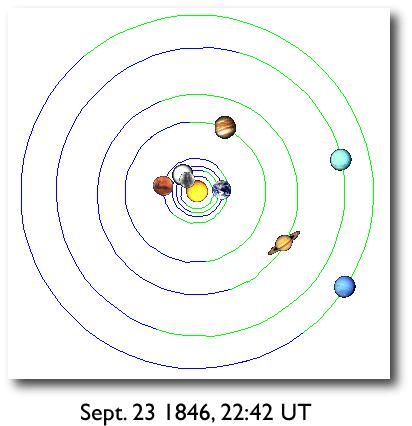
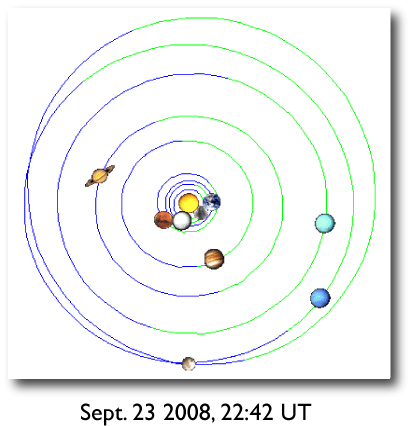
In 2011, Neptune, with its 165-year period period, will have made one full orbit since its discovery. Uranus, with an 84-year period, will have gone around the Sun almost two times.
Because the planets are fairly close to conjunction, Neptune has recently gone through the phase of its orbit where it exerts its largest perturbation on the motion of Uranus. This was similarly true in the years running up to 1846, and was responsible for LeVerrier’s sky predictions bearing such a stunning proximity to the spot where Neptune was actually discovered by Galle.
LeVerrier (and Adams) were quite fortunate. Without a computer, multi-parameter minimization is hard, and both astronomers cut down on their computational burden by assuming an incorrect distance for Neptune (based on Bode’s “law”). Their solutions were able to compensate for this incorrect assumption by invoking masses for Neptune that were much too large. They carried out remarkable calculations, but nevertheless, luck (in form of the fact that Uranus and Neptune had recently been near conjunction) played a considerable role.
Predictably, as soon as the real orbit of Neptune was determined, the playa haters tried to rush the stage. Benjamin Peirce of Harvard, in the Proceedings of the American Academy of Arts and Sciences 1, 65 (1847) described LeVerrier’s accomplishment as a mere “happy accident”:

I personally think that’s going a bit far. In any case, it’s interesting to compare the two independent predictions with the actual orbit of Neptune. I pulled the LeVerrier and Adams data in the following table from Baum and Sheehan’s book “In Search of Planet Vulcan” :
| Elements | Actual | LeVerrier | Adams |
| semimajor axis (AU) | 30.10 | 36.15 | 37.25 |
| eccentricity | 0.01121 | 0.10761 | 0.12062 |
| inclination (deg) | 1.768 | — | — |
| long. A. Node (deg) | 131.794 | — | — |
| long. Peri. (deg) | 37.437 | 284.75 | 299.18 |
| Period (yr) | 164.79 | 217.39 | 227.3 |
| Mass (Earths) | 17 | 57 | 33 |
| long. on Jan 1 1847 | 328.13 | 326.53 | 329.95 |
There’s been no shortage of hard work, and there’s been no shortage of predictions and false alarms, but nevertheless, nobody has managed to discover another solar system planet via analysis of gravitational perturbations. With the extrasolar planets, however, the prospects look a lot better. In particular, the Systemic Backend collaboration can team up with amateur observers to do the trick.
On the Systemic Backend, there are many candidate planets that have had their orbits characterized. As is usually the case with planet predictions, most of the candidates will wind up being spurious, but it’s definitely true that real planets orbiting real stars have been detected by the Backend user base. For example, Gliese 581 c was accurately characterized by the Systemic users several months before it’s announcement by the Swiss (see this post) and the same holds true for 55 Cancri f (see this post).
In the happy circumstance that a candidate planet is part of a system with a known transiting planet, then there’s an increased probability that if the candidate planet exists then it can also be observed in transit. This provides a channel for detection that completely circumvents the need for professional astronomers to carry out confirming radial velocity observations. Amateur observers are currently pushing the envelope down to milli-mag precision. Here’s an out-of-transit observation of the parent star of XO-1b by Bruce Gary:
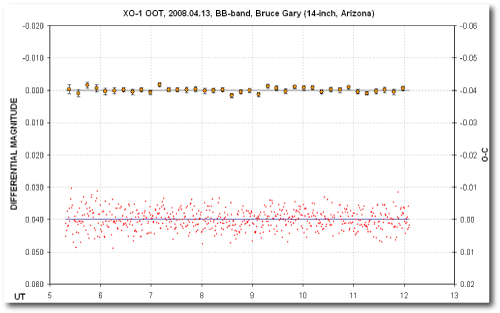
This photometry is potentially good enough to confirm a Neptune-sized planet in transit across a Solar-type star, which is absolutely amazing.
An initial proof-of-concept observation has recently been carried out. On the systemic backend, the users have been investigating the HD 17156 system, which contains a known transiting planet. User “japf ” (José Fernandes) found that a lower chi-square fit to the published radial velocity data can be obtained if there’s a 6.2 Earth-mass companion on a 1.23 day orbit.
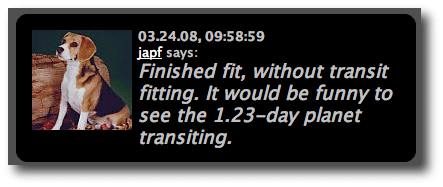
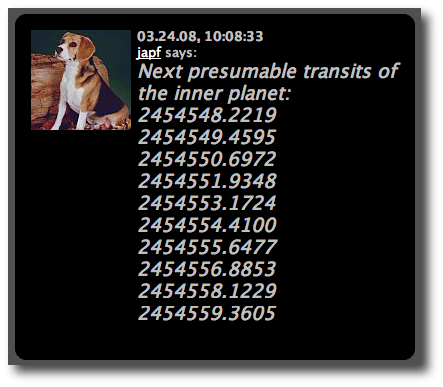
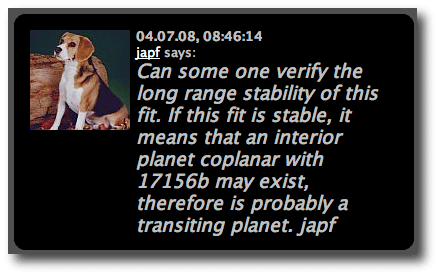
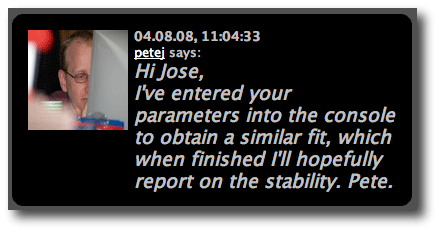

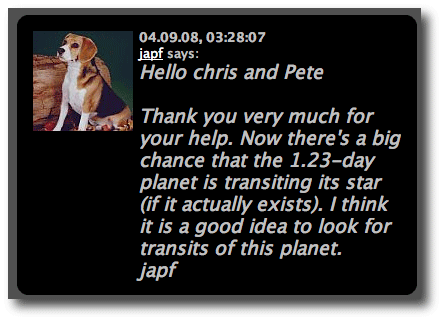
The best-fit eccentricity of the planet would bring it to a hair-raising 2 stellar radii of HD 17156, and if the planet is made of rock or water, it’ll be too small to detect, but nevertheless, it’s at least worth having a look. Jose sent the ephemeris to Bruce Gary, who observed on the opportunity falling on April 20, 04.5 UT.
No transit detected. This in itself was not at all surprising, given the long-shot nature of this particular candidate planet. What’s exciting, though, is that the full pipeline is now in place. There will definitely be strong candidates emerging over the coming months, and I think it’s quite probable that we’ll see a prediction-confirmation that is at least as good a match as was obtained for Neptune in 1846…

I know this is somewhat tangential to the subject of the post, but mention of forthcoming Neptunian anniversary has me wondering where we will be in the search for exoplanets in another Neptunian year — another 165-or-so years hence.
I understand that it’s tough enough to predict where we’ll be in 10 years let along 165, but given how far we have come since Neptune’s discovery, it would be fun to speculate how much further we can go, no?
Given that we’ll probably still be just puttering around our own Solar System in 165 years, the hunt for exoplanets will almost certainly continue be our only practical window on our galactic neighborhood. But how far will we get? Will we have a fleet of deep space telescopes combining to produce sharp images of Earth-like exoplanets by then? How many exoplanets will we have in our catalogs? Thousands? Tens of thousands? Will we be able to probe far enough to more accurately gauge the odds of life evolving elsewhere?
I would love to see a post or two of your speculations (though I would understand if you are reluctant!). Is there a foreseeable limit to the capabilities of future telescopes, even if they are on the Moon or out beyond Jupiter and Saturn? How many light years away will be able to probe without leaving our neck of the woods?
Thanks,
Mike
Talking of the Titius-Bode “law”, on the backend discussion forum some of us were recently having a discussion of whether extrasolar systems exhibit such numerical relationships between planetary orbits.
Japf created a testable hypothesis by finding that potential inner planet. What would the best way to produce testable predictions for radial velocity sets?
I would guess: comparing a given fit to the published fit for that system and looking for time windows when the RV difference between the two fits exceeds a certain threshold. That would allow more efficient targeting for the big telescopes and perhaps allow faster times to discovery for new planets.
That might be a nice function in systemic.
Chris
Tacticus: in 165 years? My guess is in order of milions catalogued planets. Premilinary list of few hundred best candidates to future (in a few hundred years) colonization. Microscopic life on many worlds taken as obvious thing. Maps of major features on close (>100 ly) worlds. Few interstellar unmanned probes with AI on board preformed flyby of closest stars, one around Alpha Centauri that orbits one of stars in this system.
These are my guesses.
Heck, some of these things (obviously in less quantity) can become real in my life. We already create very crude “maps” of hot jupiters.
Hey MaDer, nice to have an optimistic viewpoint :). You may not be too far off with most of the predictions, but I get the sense that we’re still at least a couple of centuries from sending probes to other stars. The could, of course, be an astonishing breakthrough in propulsion that could get us there, but I suspect that it will take long than that.